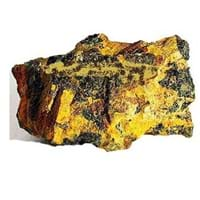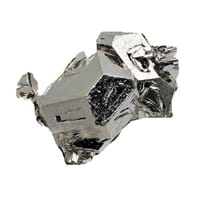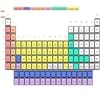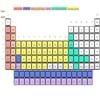Polonium vs Platinum
Periodic Table
Symbol
Po
Pt
Group Number
16
2
10
8
Period Number
6
6
Block
p block
d block
Element Family
Post-Transition
Transition Metal
CAS Number
7440086
99+
7440064
99+
Space Group Name
Pm-3m
Fm_ 3m
Space Group Number
221.00
3
225.00
2
Facts
Interesting Facts
- Polonium was the first radioactive element to be discovered.
- Polonium element and its compounds are highly radioactive.
- Its alloy with Beryllium provides source of neutrons.
- Platinum is the rarest metal from the Precious metal categories..
- Commercially Platinum is produced as a byproduct in ores of nickel.
Sources
Mining, Ores of metals
Mining, Ores of metals, Ores of Minerals
History
Who Discovered
Pierre Curie and Marie Curie
Antonio de Ulloa
Discovery
In 1898
In 1735
Abundance
Abundance In Universe
Not Available
5 * 10-7 %
19
Abundance In Sun
~-9999 %
~0.0000009 %
19
Abundance In Meteorites
Not Available
0.00 %
25
Abundance In Earth's Crust
Not Available
0.00 %
99+
Abundance In Oceans
0.00 %
99+
Not Available
Uses
Uses & Benefits
- Polonium metal has different Allotropes, it is used in antistatic devices and for research purpose.
- A 1 gram of Polonium can reach a temperature of 500°C, hence it is used as a heat source for space equipment.
- Platinum metal is mainly used in jewellery.
- Platinum is used as an industrial catalyst in production of nitric acid, silicone and benzene.
Industrial Uses
Aerospace Industry, Ammunition Industry
Aerospace Industry, Chemical Industry
Medical Uses
NA
Dentistry, Pharmaceutical Industry, Surgical Instruments Manufacturing
Other Uses
Alloys
Alloys, Bullion, Coinage, Jewellery, Sculptures, Statues
Biological Properties
Toxicity
Highly Toxic
Non Toxic
Present in Human Body
No
No
In Blood
0.00 Blood/mg dm-3
37
Not Available
In Bone
0.00 p.p.m.
36
Not Available
Physical Properties
Melting Point
254.00 °C
99+
1,772.00 °C
16
Boiling Point
962.00 °C
99+
3,827.00 °C
15
Appearance
Physical State
Solid
Solid
Color
Silver
Silvery White
Luster
NA
Metallic
Hardness
Mohs Hardness
Not Available
3.50
11
Brinell Hardness
Not Available
300.00 MPa
34
Vickers Hardness
Not Available
400.00 MPa
25
Speed of Sound
Not Available
2,800.00 m/s
29
Optical Properties
Reflectivity
Not Available
73.00 %
8
Allotropes
Yes
No
α Allotropes
α-polonium
Not Available
β Allotropes
β-polonium
Not Available
γ Allotropes
Not Available
Not Available
Chemical Properties
Chemical Formula
Po
Pt
Isotopes
Known Isotopes
29
10
35
4
Electronegativity
Pauling Electronegativity
2.00
7
2.28
3
Allred Rochow Electronegativity
1.76
2
1.44
17
Mulliken-Jaffe Electronegativity
2.48
1
Not Available
Allen Electronegativity
2.19
2
1.72
16
Electropositivity
Pauling Electropositivity
2.00
99+
1.72
99+
Ionization Energies
1st Energy Level
812.10 kJ/mol
14
870.00 kJ/mol
10
2nd Energy Level
Not Available
1,791.00 kJ/mol
21
Electrochemical Equivalent
3.90 g/amp-hr
8
1.82 g/amp-hr
35
Electron Work Function
Not Available
5.65 eV
1
Other Chemical Properties
Ionization, Radioactive Isotopes, Solubility
Chemical Stability, Anti Corrosion, Ionization
Atomic Properties
Atomic Number
84
32
78
38
Electron Configuration
[Xe] 4f14 5d10 6s2 6p4
[Xe] 4f14 5d9 6s1
Crystal Structure
Monoclinic (MON)
Face Centered Cubic (FCC)
Crystal Lattice
MON-Crystal-Structure-of-Polonium.jpg#100
FCC-Crystal-Structure-of-Platinum.jpg#100
Atom
Number of Protons
84
32
78
38
Number of Neutrons
125
19
117
24
Number of Electrons
84
32
78
38
Radius of an Atom
Atomic Radius
168.00 pm
23
139.00 pm
39
Covalent Radius
140.00 pm
99+
136.00 pm
99+
Van der Waals Radius
197.00 pm
29
175.00 pm
36
Atomic Weight
209.00 amu
28
47.87 amu
99+
Atomic Volume
22.23 cm3/mol
13
9.09 cm3/mol
99+
Adjacent Atomic Numbers
Valence Electron Potential
Not Available
392.42 (-eV)
1
Lattice Constant
335.90 pm
99+
392.42 pm
24
Lattice Angles
π/2, π/2, π/2
π/2, π/2, π/2
Lattice C/A Ratio
Not Available
Not Available
Mechanical Properties
Density
Density At Room Temperature
9.20 g/cm3
99+
21.45 g/cm3
11
Density When Liquid (at m.p.)
9.40 g/cm3
19
19.77 g/cm3
2
Tensile Strength
Not Available
125.00 MPa
14
Viscosity
Not Available
Not Available
Vapor Pressure
Vapor Pressure at 2000 K
Not Available
0.07 (Pa)
18
Elasticity properties
Shear Modulus
Not Available
61.00 GPa
14
Bulk Modulus
Not Available
230.00 GPa
6
Young's Modulus
Not Available
168.00 GPa
14
Poisson Ratio
Not Available
0.38
6
Other Mechanical Properties
NA
Ductile, Malleable
Magnetic Properties
Magnetic Characteristics
Specific Gravity
9.32
31
21.45
4
Magnetic Ordering
Nonmagnetic
Paramagnetic
Permeability
Not Available
0.00 H/m
3
Electrical Properties
Electrical Property
Conductor
Conductor
Resistivity
0.40 nΩ·m
99+
105.00 nΩ·m
30
Electrical Conductivity
0.02 106/cm Ω
99+
0.10 106/cm Ω
21
Electron Affinity
183.30 kJ/mol
3
205.30 kJ/mol
2
Thermal Properties
Specific Heat
0.12 J/(kg K)
40
0.13 J/(kg K)
39
Molar Heat Capacity
26.40 J/mol·K
28
25.86 J/mol·K
35
Thermal Conductivity
20.00 W/m·K
99+
71.60 W/m·K
24
Critical Temperature
Not Available
Not Available
Thermal Expansion
23.50 µm/(m·K)
16
8.80 µm/(m·K)
99+
Enthalpy
Enthalpy of Vaporization
60.30 kJ/mol
99+
510.50 kJ/mol
11
Enthalpy of Fusion
13.00 kJ/mol
26
19.70 kJ/mol
12
Enthalpy of Atomization
134.00 kJ/mol
99+
565.00 kJ/mol
11
Standard Molar Entropy
Not Available
41.60 J/mol.K
36
|
||
|
||
|












